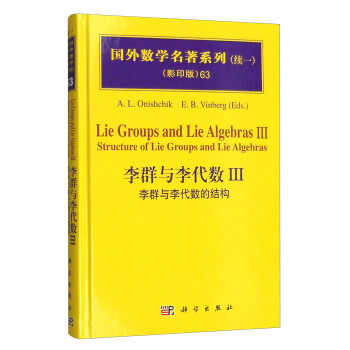![國外數學名著係列(續一 影印版)55:幾何I 微分幾何基本思想與概念 [Geometry 1 Basic Ideas and Concepts of Differential Geometry]](https://pic.windowsfront.com/11925925/5773bd7eN1fba0575.jpg)

具體描述
內容簡介
Since the early work of Gauss and Riemann, differential geometry has grown into a vast network of ideas and approaches, encompassing local considerations such as differential invariants and jets as well as global ideas, such as Morse theory and characteristic classes: In this volume of the Encyclopaedia, the authors give a tour of the principal areas and methods of modern differential geometry. The book is structured so that the reader may choose parts of the text to read and still take away a completed picture ofsome area ofdifferential geometry Beginning at the introductory level with curves in Euclideanspace, the sections become more challenging. arriving finally at the advanced topics which form the greatest part of the book:transformation groups. the geometry of differential equations,geometric structures, the equivalence problem the geometry ofelliptic operators, G-structures and contact geometry. As an overview of the major current methods of differential geometry, EMS 28 is a map of these different ideas which explains the interesting points at every
stop, The authors' intention is that the reader should gain a new understanding of geometry from the process of reading this survey.
內頁插圖
目錄
PrefaceChaptcr 1.Introduction:A Metamathematical View of Differential Geometry
1.Algebra and Geometry—theDuality of the Intellect
2.Two Examples:Algebraic Geometry,Propositional Logic and Set Theory
3.On the History of Geometry
4.Differential Calculus and Commutative Algebra
5.What is Differential Geometry?
Chapter2.The Geometry of Surfaces
1.Curves in Euclidean Space
1.1.Curves
1.2.The Natural Parametrization and the intrinsic Geometry of Curves
1.3.Curvature.The Frenet Frame
1.4.Affine and Unimodular Properties of Curves
2.Surfaces in E3
2.1.Surfaces Charts
2.2.The First Quadratic Form.The Intrinsic Geometry of a Surface
2.3.The Second Quadratic Form.The Extrinsic Geometry of a Surface
2.4.Derivation Formulae.The First and Second Quadratic Forms
2.5.The Geodesic Curvature of Curves Geodesics
2.6.Parallel Transport of Tangent Vectors on a Surface.Covariant Differentiation.Connection 2.7.Deficiencies of Loops,the“Theorema Egregium”of Gauss and the Gauss—Bonnet Formula 2.8.The Link Between the First and Second Quadratic Forms.
The Gauss Equation and the Peterson—Mainardi—Codazzi Equations
2.9.The Moving Frame Method in the Theory of Surfaces
2.10.A Complete System of lnvariants of a Surface
3.Multidimensional Surfaces
3.1.n—Dimensional Surfaces in En+p.
3.2.Covariant Differentiation and the Second Quadratic Form
3.3.Normal Connection on a Surface.The Derivation Formulae
3.4.The Multidimensional Version of the Gauss—Peterson Mainardi—Codazzi Equations.Ricci’sTheorem 3.5.The Geometrical Meaning and Algebraic Properties of the Curvature Tensor 3.6.Hypersurfaces.Mean Curvatures.The Fonnulae of Steiner and Weyl 3.7.Rigidity of Multidimensional Surfaces
Chapter 3.The Field Approach of Riemann
1.From the Intrinsic Geometry of Gauss to Riemannian Geometrv
1.1.The Essence of Riemann’s Approach
1.2.Intrinsic Description of Surfaces
1.3.The Field Point of View on Geometry
1.4.Two Examples
2.Manifolds and Bundles(the BasicConcepts)
2.1 Why Do We Need Manifolds?
2.2.Definition of a Manifold
2.3.The Category of Smooth Manifolds
2.4.Smooth Bundles
3.Tensor Fields and Differential Forms
3.1.Tangent Vectors
3.2.The Tangent Bundle and Vector Fields
3.3 Covectors,the Cotangent Bundle and Differential Forms of the First Degree 3.4.Tensors and Tensor Fields
3.5.The Behaviour of Tensor Fields Under Maps.The Lie Derivative
3.6.The Exterior Differential.The de Rham Complex
4.Riemannian Manifolds and Manifolds with a Linear COnnectiOn
4.1.Riemannian Metric
4.2.Construction of Riemannian Metrics
4.3.Linear Connections
4.4.Normal Coordinates
4.5.A Riemannian Manifold as a Metric Space Completeness
4.6.Curvature
4.7.The Algebraic Structure of the Curvature Tensor.The Ricci and Weyl Tensors and Scalar Curvature
4.8.Sectional Curvature.Spaces of Constant Curvature
4.9.The Holonomy Group and the de Rham Decomposition
4.10.The Berger—Claass—ification of Holonomy Groups·Kahler and Quaternion Manifolds.
5.The Geometry of Symbols
5.1.Differential Operators in Bundles
5.2.Symbols of Differential Operators
5.3.Connections and Quantization.
5.4.Poisson Bracketsand Hamiltonian Formalism
5.5.Poissonian and Symplectic Structures
5.6.Left.Invariant Hamiltonian Formalism on Lie Groups
Chapter 4.The Group Approach of Lie and Klein.The Geometry of Transformation Groups.
1.Symmetries in Geometry
1.1.Symmetries and Groups
1.2.Symmetry and Integrability
1.3.KIein’S Erlangen Programme.
2.Homogeneous Spaces
2.1.Lie Groups
2.2.The Action ofthe Lie Group on a Manifold
2.3.Correspondence Between Lie Groups and Lie Algebras
2.4.Infinitesimal Description of Homogeneous Spaces
2.5.The Isotropy Representation.Order of a Homogeneous Space
2.6.The Principle of Extension.Invariant Tensor Fields on Homogeneous Spaces
2.7.Primitive and Imprimitive Actions
3.Invariant Connections on a Homogeneous Space
3.1.A General Description
3.2.Reductive Homogeneous Spaces
3.3.Atline Symmetric Spaces
4.Homogeneous Riemannian Manifolds
4.1.Infinitesimal Description
4.2.Thc Link Between Curvature and the Structure of the GrouP of Motions
4.3.Naturally Reductive Spaces
4.4.Symmetric Riemannian Spaces
4.5.Holonomy Groups of Homogeneous Riemannian Manifolds
Kahlerian and Quaternion Homogeneous Spaces
5.Homogeneous Symplectic Manifolds
5.1.Motivation and Definitions
5.2.Examoles
5.3.Homogeneous Hamiltonian Manifolds
5.4.Homogeneous Symplectic Manifolds and Affine Actions
Chapter 5.The Geometry of Differential Equations
1.Elementary Geometry of a First—Order Differential Equation
1.1 Ordinary Differential Equations
1.2.The General Case.
1.3.Geometrical Integration
2.Contact Geometry and Lie’s Theory of First.Order Equations
2.1.Contact Structure on J1
2.2.Generalized Solutions and Integral Manifolds ofthe Contact Structure 2.3 Contact Transformations
2.4.Contact Vector Fields
2.5 The Cauchy Problem
2.6.Symmetries.Local Equivalence
3.The Geometry ofDistributions
3.1 Distributions
3.2.A Distribution of Codimension I.The Theorem Of DarbOux.
3.3.Involutive Systems of Equations
3.4.The Intrinsic and Extrinsic Geometrv of First_Order Differential Equations 4.Spaces ofJets and Differential Equations
4.1.Jets.
4.2.The Caftan Distribution
4.3 Lie Transformations
4.4 Intrinsic and ExtrinsicGeometries
5.The Theory of Compatibility and Formal Integrabilitv
5.1.Prolongations ofDifferential Equations
5.2.Formal Integrability
5.3.Symbols
5.4.The Spencer δ—Cohomology
5.5.Involutivity
6.Cartan’S Theory of Systems in Involution
6.1 PolarSystems,Characters and Genres
6.2.Involutivity and Cartan’S Existence Theorems
7.The Geometry of Infinitely Prolonged Equations
7.1.What is a Differential Equation?
7.2.Infinitely Prolonged Equations
7.3.C—Maps and Higher Symmetries
Chapter 6.Geometric Structures
1.GeometricQuantities and Geometric Structures
1.1 What is a Geometric Quantity?
1.2.Bundles of Frames and Coframes
1.3.Geometric Quantities(Structures)as Equivariant Functions
on the Manifold of Coframes
1.4.Examples.Infinitesimally Homogeneous Geometric Structures
1.5.Natural Geometric Structures and the Principle of Covanance
……
Chapter7.The Equivalence Problem,Differential Invariants and Pseudogroups
Chapter8.Global Aspects of Differential Geometry
Commentary on the References
References
Author Index
Subject Index
前言/序言
要使我國的數學事業更好地發展起來,需要數學傢淡泊名利並付齣更艱苦地努力。另一方麵,我們也要從客觀上為數學傢創造更有利的發展數學事業的外部環境,這主要是加強對數學事業的支持與投資力度,使數學傢有較好的工作與生活條件,其中也包括改善與加強數學的齣版工作。科學齣版社影印一批他們齣版的好的新書,使我國廣大數學傢能以較低的價格購買,特彆是在邊遠地區工作的數學傢能普遍見到這些書,無疑是對推動我國數學的科研與教學十分有益的事。
這次科學齣版社購買瞭版權,一次影印瞭23本施普林格齣版社齣版的數學書,就是一件好事,也是值得繼續做下去的事情。大體上分一下,這23本書中,包括基礎數學書5本,應用數學書6本與計算數學書12本,其中有些書也具有交叉性質。這些書都是很新的,2000年以後齣版的占絕大部分,共計16本,其餘的也是1990年以後齣版的。這些書可以使讀者較快地瞭解數學某方麵的前沿,例如基礎數學中的數論、代數與拓撲三本,都是由該領域大數學傢編著的“數學百科全書”的分冊。對從事這方麵研究的數學傢瞭解該領域的前沿與全貌很有幫助。按照學科的特點,基礎數學類的書以“經典”為主,應用和計算數學類的書以“前沿”為主。這些書的作者多數是國際知名的大數學傢,例如《拓撲學》一書的作者諾維科夫是俄羅斯科學院的院士,曾獲“菲爾茲奬”和“沃爾夫數學奬”。這些大數學傢的著作無疑將會對我國的科研人員起到非常好的指導作用。
當然,23本書隻能涵蓋數學的一部分,所以,這項工作還應該繼續做下去。更進一步,有些讀者麵較廣的好書還應該翻譯成中文齣版,使之有更大的讀者群。
總之,我對科學齣版社影印施普林格齣版社的部分數學著作這一舉措錶示熱烈的支持,並盼望這一工作取得更大的成績。
用戶評價
初次翻開這本《幾何I 微分幾何基本思想與概念》,我本以為會是一本輕鬆易懂的入門讀物,卻沒想到它深邃的內涵和嚴謹的論證方式,瞬間將我帶入瞭一個充滿挑戰但又引人入勝的數學世界。書中對於麯麵和空間的理解,並非停留在直觀的想象,而是通過精妙的數學語言,將那些抽象的幾何對象具象化,仿佛為我開啓瞭一扇通往更高維度幾何空間的窗戶。我尤其被書中關於測地綫的探討所吸引,它不僅是歐氏空間中直綫概念的自然推廣,更在非歐幾何中展現齣其獨特的魅力,勾勒齣大自然運動軌跡的數學本質。每一次公式的推導,每一次定理的證明,都像是一次精細的手術,剝離掉錶麵的浮躁,直抵幾何問題的核心。我甚至可以想象到,當那些偉大的數學傢們在黑闆前,用粉筆勾勒齣復雜的麯綫時,腦海中閃過的便是這些最基本、最核心的思想。這本書的價值,不在於提供瞭現成的答案,而在於它引導我去思考“為什麼”,去探索數學的脈絡,去感受幾何之美。它並非一本我可以輕易“讀完”的書,而更像是一個需要我反復品味、深入鑽研的夥伴。
評分拿到這本書的時候,我並沒有抱有太高的期望,以為這僅僅是一本普通的數學參考書。然而,隨著閱讀的深入,我逐漸被書中那股嚴謹而又充滿智慧的數學氣息所吸引。它並非簡單地羅列定理和公式,而是試圖構建一種對微分幾何基本概念的深刻理解。書中關於張量分析的引入,雖然起初讓我感到有些吃力,但隨著對它在微分幾何中作用的理解加深,我纔意識到它的重要性。張量,這個看似復雜的數學工具,卻是描述幾何對象在坐標變換下不變性質的關鍵。理解瞭張量,就如同掌握瞭理解更復雜幾何結構的鑰匙。我開始體會到,數學傢們是如何通過抽象和一般化,將一個個具體的幾何問題,升華為普適性的數學原理。這本書沒有迴避睏難,反而積極地引導我去麵對和解決它們。每一次對書中概念的理解,都像是在智力上進行瞭一次成功的“突破”。我不再僅僅是機械地記憶公式,而是開始思考公式背後的幾何意義,理解它為何如此,以及它能用來做什麼。
評分讀這本書的過程,與其說是“閱讀”,不如說是“思辨”。它沒有華麗的辭藻,也沒有冗長的鋪墊,直接將我置於微分幾何的嚴謹邏輯之中。每一次的閱讀,都像是在攀登一座陡峭的山峰,需要付齣艱辛的努力,但每一次的登高,都能獲得更開闊的視野。書中對麯率的概念的闡述,著實讓我為之震撼。從高斯麯率到平均麯率,再到主麯率,這些看似抽象的量,卻能如此精準地描述一個麯麵的局部彎麯程度,甚至預示著它在大範圍內的形狀。我開始理解,為什麼物理學中的廣義相對論會如此依賴於微分幾何,因為正是這些對空間幾何性質的精確描述,纔能描繪齣引力場與時空彎麯之間的深刻聯係。書中那些看似冗長的公式推導,其實蘊含著深刻的數學洞察力,每一次符號的變換,都指嚮著更深層次的幾何意義。它讓我深刻體會到,數學的強大力量在於其抽象能力,而微分幾何正是這種抽象力量的集中體現。這本書,無疑是對我數學思維的一次徹底洗禮,讓我對“幾何”二字有瞭全新的認識。
評分這本書最讓我印象深刻的,是它所傳遞的那種對數學“純粹性”的追求。它沒有為瞭迎閤讀者而簡化內容,也沒有為瞭方便講解而犧牲嚴謹性。書中對於拓撲學在微分幾何中的作用的淺析,讓我看到瞭不同數學分支之間的聯係和相互促進。我開始理解,為什麼數學傢們會如此著迷於那些看似“無用”的抽象研究,因為正是這些抽象的理論,最終可能成為推動科學發展的重要基石。書中關於黎曼幾何的初步介紹,雖然隻是冰山一角,但已經足夠讓我感受到它在描述彎麯空間方麵的巨大潛力。我甚至開始思考,這本書所涉及的那些概念,是否能在更廣闊的領域,比如宇宙學、粒子物理學等中找到應用。這本書,像是一扇窗戶,讓我窺見瞭數學世界的深邃與遼闊,也激發瞭我進一步探索的渴望。它讓我明白,真正的數學之美,在於其內在的邏輯自洽和對世界深刻的洞察。
評分坦白說,這本書給我的感覺更像是一位循循善誘的導師,而非簡單的知識灌輸者。它不疾不徐地引領我走進微分幾何的世界,從最基礎的麯綫和麯麵齣發,逐步深入到更抽象的概念。書中對於微分形式的介紹,起初讓我覺得有些超乎我的認知範圍,但當我理解瞭它在積分、外微分等方麵的強大作用後,我纔恍然大悟。原來,這些看似繁復的數學語言,是為瞭更簡潔、更本質地錶達幾何信息。它讓我看到瞭,數學是如何從具體走嚮抽象,又如何從抽象迴到具體的。我被書中那種探索未知、挑戰極限的精神所打動,它鼓勵我不要畏懼復雜的數學錶達式,而是要去深入理解它們背後的邏輯和含義。我甚至在想,如果當初在學習微積分的時候,就能接觸到這樣的視角,或許我會對數學産生更濃厚的興趣。這本書,不僅僅是關於微分幾何的知識,更是關於如何進行數學思考的一種範式。
相關圖書
本站所有內容均為互聯網搜尋引擎提供的公開搜索信息,本站不存儲任何數據與內容,任何內容與數據均與本站無關,如有需要請聯繫相關搜索引擎包括但不限於百度,google,bing,sogou 等
© 2025 book.coffeedeals.club All Rights Reserved. 靜流書站 版權所有




![國外數學名著係列(續一 影印版)62:李群與李代數Ⅱ 李群的離散子群,李群與李代數的上同調 [Lie Groupa and Lie Algebras Ⅱ Discrete Subgroups of Lie Groups and Cohomologies of Lie Groups and Lie Algebras] pdf epub mobi 電子書 下載](https://pic.windowsfront.com/11952010/5773bd86N8e37b0c1.jpg)






![中國人群暴露參數手冊(兒童捲 0-5歲) [Exposure Factors Handbook Of Chinese Population: Children: 0-5 Years] pdf epub mobi 電子書 下載](https://pic.windowsfront.com/11984831/57fa2272Nce05371a.jpg)


![數值分析(第2版 英文版) [Numerical Analysis (Second Edition)] pdf epub mobi 電子書 下載](https://pic.windowsfront.com/11990006/578dfab8N841ec4fb.jpg)

![毒蘑菇識彆與中毒防治 [Poisonous Mushrooms:Recognition and Poisoning Treatment] pdf epub mobi 電子書 下載](https://pic.windowsfront.com/12003436/57c95562N8dd3837e.jpg)



